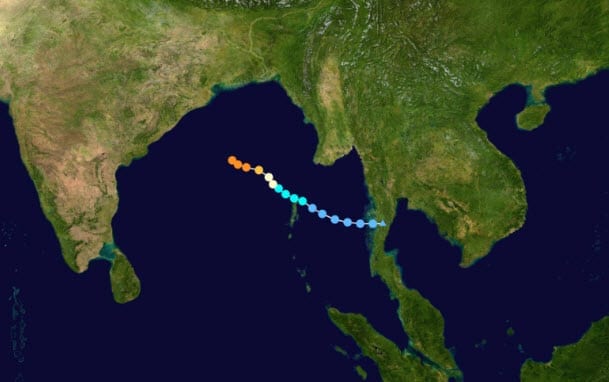BOSTON, Oct. 11, 2013 – According to catastrophe modeling firm AIR Worldwide, currently several hundred kilometers off of the eastern coast of India, Very Severe Cyclonic Storm Phailin is expected to make landfall on Saturday evening, local time, north of the city of Visakhapatnam. The storm is expected to severely impact areas in the states of Odisha and Andhra Pradesh.
AIR expects significant damage from this event. Heavy to very heavy rainfall over large areas of Andhra Pradesh and Odisha, along with extremely heavy rainfall in some areas, will likely bring significant inland flooding. Storm surge will also likely inundate low lying areas of Ganjam, Khurda, Puri, and Jagatsinghpur districts of Odisha and Srikakulam district of Andhra Pradesh. Strong winds will likely cause significant damage to older structures and structures made from unreinforced masonry (the dominant residential construction type). Newer buildings made from confined masonry and reinforced concrete will likely not be as heavily affected.
Fourteen years ago, a super cyclonic storm struck India near the same location and caused the deaths of an estimated 10,000 people. Indian authorities have raised a high alert across the eastern coast.
“The storm is approximately 400 km off the eastern coast of India in the Bay of Bengal,” said Dr. Peter Sousounis, senior principal scientist, AIR Worldwide. “Phailin, which is about half the size of India, is expected to make landfall Saturday evening, local time, between Kalingapatnam in Andhra Pradesh and the port of Paradip in Odisha state. Currently located in a low shear and high sea-surface temperature (greater than 28°C) environment, Phailin is forecast to intensify slightly before landfall, but then weaken to its current intensity at landfall. The storm currently packs sustained maximum surface wind speeds of 210-220 km/h (130-135 mph) and gusts up to 235 km/h (146 mph), according to the India Meteorological
Department (IMD).”
The Joint Typhoon Warning Center (JTWC) currently estimates Phailin to have maximum sustained wind speeds of 250 km/h (155 mph) and gusts of up to 315 km/h (195 mph). The forecast track is similar to that of the IMD, and intensity at landfall is likewise expected to be close to its current strength (higher than that estimated by the IMD).
IMD).
The IMD expects heavy to very heavy rainfall for most places affected by Phailin, with 20 cm of recipitation expected over a large swath and extremely heavy rainfall (>25 cm) in some areas. Inland flooding is possible. Seas in the affected areas are expected to be rough to very rough. A 3-3.5 m (about 10 to 11 feet) storm surge above astronomical tides is also forecast by the IMD, which would inundate low lying areas of Ganjam, Khurda, Puri, and Jagatsinghpur districts of Odisha and Srikakulam district of Andhra Pradesh during landfall.
Dr. Sousounis noted, “The northeast Indian coast is extremely prone to storm surge flooding, which makes this peril a major concern for low-lying areas. Many of the world’s deadliest tropical cyclones have arrived from the Bay of Bengal because of the region’s extreme vulnerability to storm surge flooding.”
According to AIR, Indian authorities warned of extensive damage to crops, village dwellings, and old buildings, as well as disruption of power, water, and rail services. Farmers have been asked to harvest crops if they are ready, or to bundle them together and drain stagnating water from fields to minimize damage.
According to AIR, historically, the dominant construction type in India has been unreinforced masonry. This construction is typically made from various traditional materials, including adobe, rubble stone, or burnt brick. Unreinforced masonry is still pervasive throughout rural India in low- and mid-rise residential and commercial structures. Also, increasingly, modern urban buildings in India are employing more durable construction types, such as confined masonry and reinforced concrete. Moreover, these buildings are incorporating advanced features in their design and are subject to better construction practices and stricter code enforcement. This is particularly true of new high-rise buildings, which are generally made of reinforced concrete, as well as of complex industrial facilities, which often comprise reinforced concrete, steel, and light metal construction.
Dr. Sousounis concluded, “Inland exposure concentrations are also at risk to tropical cyclones. It is common for systems to persist thousands of kilometers inland before dissipating, producing heavy rainfall that can trigger widespread flooding. Heavy rainfall can produce flooding as rain flows down slopes and collects in low-lying areas, and rainfall causes river- and streambeds to overflow and flood surrounding regions. In 1999, significant rainfall from a Category 5 super cyclone (now called the Odisha or Orissa cyclone) caused widespread flooding in the coastal regions of Odisha state. The area where Phailin is forecast to make landfall, about 150 km to the southwest of the 1999 cyclone, is not as low-lying.”
AIR will continue to monitor Cyclone Phailin and will provide updates as necessary.
